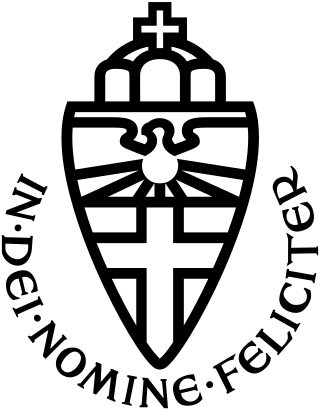
Nanotechnology is the manipulation of matter with at least one dimension sized from 1 to 100 nanometers (nm). At this scale, commonly known as the nanoscale, surface area and quantum mechanical effects become important in describing properties of matter. This definition of nanotechnology includes all types of research and technologies that deal with these special properties. It is common to see the plural form "nanotechnologies" as well as "nanoscale technologies" to refer to research and applications whose common trait is scale. An earlier understanding of nanotechnology referred to the particular technological goal of precisely manipulating atoms and molecules for fabricating macroscale products, now referred to as molecular nanotechnology.

Surface science is the study of physical and chemical phenomena that occur at the interface of two phases, including solid–liquid interfaces, solid–gas interfaces, solid–vacuum interfaces, and liquid–gas interfaces. It includes the fields of surface chemistry and surface physics. Some related practical applications are classed as surface engineering. The science encompasses concepts such as heterogeneous catalysis, semiconductor device fabrication, fuel cells, self-assembled monolayers, and adhesives. Surface science is closely related to interface and colloid science. Interfacial chemistry and physics are common subjects for both. The methods are different. In addition, interface and colloid science studies macroscopic phenomena that occur in heterogeneous systems due to peculiarities of interfaces.

Radboud University (abbreviated as RU, Dutch: Radboud Universiteit, formerly Katholieke Universiteit Nijmegen) is a public research university located in Nijmegen, the Netherlands. RU has seven faculties and more than 24,000 students.

James Kazimierz Gimzewski is a Scottish physicist of Polish descent who pioneered research on electrical contacts with single atoms and molecules and light emission using scanning tunneling microscopy (STM).

The Department of Materials at the University of Oxford, England was founded in the 1950s as the Department of Metallurgy, by William Hume-Rothery, who was a reader in Oxford's Department of Inorganic Chemistry. It is part of the university's Mathematical, Physical and Life Sciences Division

The Fritz Haber Institute of the Max Planck Society (FHI) is a science research institute located at the heart of the academic district of Dahlem, in Berlin, Germany.

The Swiss Nanoscience Institute (SNI) at the University of Basel is a center of excellence for nanosciences and nanotechnology in Northwestern Switzerland. It was founded in 2006 by the Canton of Aargau and the University of Basel to succeed the National Center of Competence in Research (NCCR) Nanoscale Science. Its mission is to support research, technology transfer, and academics in the nanoscience's and nanotechnology. The SNI is based on an interdisciplinary network of partner organizations and researchers who participate in basic or applied research projects and are involved in educating nanoscience's students and doctoral students at the University of Basel. The SNI includes the Nano Technology Center at the University of Basel, which encompasses the Nano Imaging Lab and the Nano Fabrication Lab. These two service units provide academic institutions and industrial companies with services in the areas of microscopic imaging and analysis and nanofabrication.
The following outline is provided as an overview of and topical guide to nanotechnology:
NanoNed is the Nanotechnology Research and Development initiative of Dutch Government. It is financed Ministry of Economic Affairs (Netherlands).Dutch Technology Foundation STW is responsible for the program management of NanoNed. It is a consortium of seven universities, TNO and Philips. University of Leiden, University of Utrecht and FOM institute AMOLF in Amsterdam are also the partners of NanoNed. Around 400 researchers are working within all these partners. On the basis of National Research and Development strength and industrial needs, 11 interdependent program has developed and named as "Flagship". Each of these flagships is led by a "Flagship Captain". In 2009, more than 400 researchers are working in different 200 projects.

Bai ChunliForMemRS HonFRSC HonFRSE is a Chinese physical chemist, nanotechnology scientist, and academic administrator. He is a professor at the Chinese Academy of Sciences Institute of Chemistry.
The Bijvoet Centre for Biomolecular Research is a research institute at Utrecht University. The Bijvoet Centre performs research on the relation between the structure and function of biomolecules, including proteins and lipids, which play a role in biological processes such as regulation, interaction and recognition. The Bijvoet Centre houses advanced infrastructures for the analysis of proteins and other biomolecules using NMR, X-ray crystallography, electron microscopy and mass spectrometry. The institute is named after famous Dutch chemist Johannes Martin Bijvoet, who worked at Utrecht University.
Paolo Samorì is an Italian physical chemist and Distinguished Professor (PRCE) at the Institut de Science et d'Ingénierie Supramoléculaires (ISIS) of the Université de Strasbourg (UNISTRA) & CNRS where he heads the Nanochemistry Laboratory and he has been institute director (2012-2023).
Jürgen P. Rabe is a German physicist and nanoscientist.

The Strasbourg Institute of Material Physics and Chemistry is a joint research unit between the French National Center for Scientific Research (CNRS) and the University of Strasbourg. It was founded in 1987 and is located in the district of Cronenbourg in Strasbourg, France.

Dawn Austin Bonnell is the Senior Vice Provost for Research at the University of Pennsylvania. She has previously served as the Founding Director of the National Science Foundation Nano–Bio Interface Center, Vice President of the American Ceramic Society and President of the American Vacuum Society. In 2024, she was elected to the American Philosophical Society.
Sylvia Speller was born on June 17, 1967, in Haren, Germany. She is a German physicist who obtained her Dr. rer. nat. from the University of Osnabruck (1995) and has been a professor in the faculty of mathematics and natural sciences at the University of Rostock since 2012. She teaches and researches experimental physics, specifically, surface and interface physics, nanophysics, and scanning probe methods. Speller is currently a member of the German Physical Society.
Daniela A. Wilson is a Romanian scientist of organic chemistry known for her research regarding self-assembly, polymer chemistry and nanomotors. She currently holds the position of professor of systems chemistry at Radboud University Nijmegen and holds a chair at the Institute for Molecules and Materials.
Petra de Jongh is a Dutch materials chemist, currently working as a professor of Catalysts and Energy Materials at the Debye Institute for Nanomaterials Science at Utrecht University. Her research spans many fields, tackling issues like converting and storing renewable sources of energy, developing lighter, sustainable batteries, reducing energy consumption, and designing catalysts for chemical conversions. De Jongh is the first female winner of the Gilles Holst Medal, which is given to outstanding researchers in the Netherlands, who have made significant contributions to the fields of applied chemistry or physics.
Leonhard Grill is an Austrian experimental physicist. He is a professor at the University of Graz in the field of nanoscience, in particular with functional molecules on surfaces.









